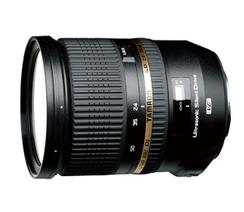The Tamron SP designation is reserved for lenses developed with special emphasis on extraordinary photographic performance. Engineers are free to innovate in an uncommon atmosphere where optical performance comes before price, resulting in lenses that satisfy the demands of discerning photographers.
Play with light as you explore the subtle aspects of beauty. An all-new, high-speed standard zoom lens with image stabilization.
Tamron Di lenses are performance optimized for digital SLR cameras and usable with DSLRs featuring sensors commonly referred to as APS-C, measuring approximately 24mm x 16mm, as well as larger full frame (36mm x 24mm) sensors and 35mm film SLRs.
Tamron Di lenses are performance optimized for digital SLR cameras and usable with DSLRs featuring sensors commonly referred to as APS-C, measuring approximately 24mm x 16mm, as well as larger full frame (36mm x 24mm) sensors and 35mm film SLRs
Super Performance for Discriminating Shooters
Tamron SP (Super Performance) series is a line of ultra-high-performance lenses designed and manufactured to the exacting specifications demanded by professionals and others who require the highest possible image quality. In creating SP lenses Tamron's optical designers put their foremost priority on achieving superior performance parameters -- they are all designed to a higher standard with little regard for cost constraints. As a result, Tamron lenses bearing the SP designation feature impressive and innovative designs that have established an enviable reputation for excellence among those knowledgeable photographers that demand the very best.
Special Glass for Better Performance and More Compact Lens Designs
XR (Extra Refractive Index) glass can bend light rays at steeper angles, thereby decreasing the physical length of the lens while enhancing imaging performance by minimizing optical aberrations. This has allowed Tamron to develop a line of shorter, smaller-diameter, lighter lenses without sacrificing lens speed, and actually upgrading image quality compared to older designs. XR glass is costlier than conventional glass but it yields enhanced optical power distribution, making possible many of the outstanding and innovative lens designs that bear the XR designation. XR glass, with its superior light-bending power, makes it possible to design a short-barrel lens with the same light-gathering ability (aperture value) as a long-barrel lens -- even with a smaller lens diameter. By using this principle Tamron has been able to shorten the length of the entire optical system and produce lighter, more compact lenses of the same speed, and also to provide greater zoom ranges in lenses that are much more convenient to carry and hand-hold.
Tamron's Unique State-of-the-Art In-Lens Image Stabilization System
Handheld camera shake is the leading cause of blurry and unsharp pictures. Several leading companies now make lenses with built-in optical image-stabilization systems that sense the amplitude and direction of the shake and compensate by moving optical groups within the lens. Tamron's exclusive new Vibration Compensation (VC) system that's built into the Tamron AF28-300mm F/3.5-6.3 XR Di VC LD Aspherical (IF) Macro and the Tamron AF18-270mm F/3.5-6.3 Di-II VC LD Aspherical (IF) Macro lenses performs a similar function, but it executes it much more effectively due to its innovative breakthrough design.
Ultrasonic Silent Drive
Tamron's USD works with the high-frequency ultrasonic vibrations that are produced by a ring called a 'stator'. Energy from the vibrations is used to rotate an attached metallic ring known as the 'rotor'. Piezoelectric ceramic, an element that produces ultrasonic vibrations when voltage of a specific frequency is applied is arranged in a ring formation on the stator. This electrode configuration of piezoelectric ceramic causes two ultrasonic vibrations to occur in the stator.
By effectively combining these two ultrasonic vibrations, it is possible to convert the energy from the vibrations that produced simple motion into energy known as 'deflective traveling waves', which then moves around the circumference (rotation direction) of the ring.
With the USD, the friction between these deflective traveling waves created on the metallic surface of the stator and the surface of the rotor produce force, causing the rotor to rotate. The focusing ring lens, which is linked to the rotor, is thus moved, creating a fast and smooth auto-focus drive.
Low Dispersion (LD) Glass for Greater Lens Sharpness
Low dispersion (LD) glass elements in a lens help reduce chromatic aberration; the tendency of light of different colors to come to different points of focus at the image plane. Chromatic aberration reduces the sharpness of an image, but glass with an extremely lowdispersion index, has less of a tendency to separate (defract) a ray of light into a rainbow of colors. This characteristic allows the lens designer to effectively compensate for chromatic aberration at the center of the field (on axis), a particular problem at long focal lengths (the telephoto end of the zoom range), and for lateral chromatic aberration (towards the edges of the field) that often occurs at short focal lengths (the wide-angle end of the zoom range.)
* Image stabilization is an integrated function of Sony Alpha-mount DSLRs and would conflict lens-based IS. Therefore, the Tamron VC function is omitted from models manufactured for Sony Alpha-mount DSLRs.
*1 With SLR cameras corresponding to APS-C, the angle of view based on 35mm equivalent focal length will range from 37mm to 109mm.
*2 This rounded diaphragm retains a nearly circular shape even when taken two stops down from its fully open state.

